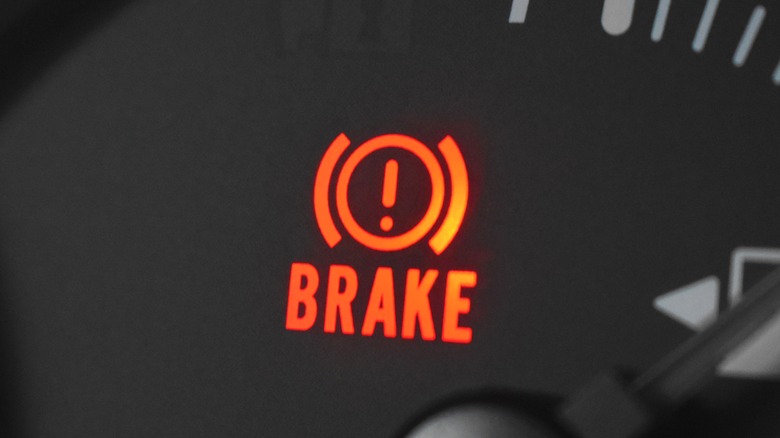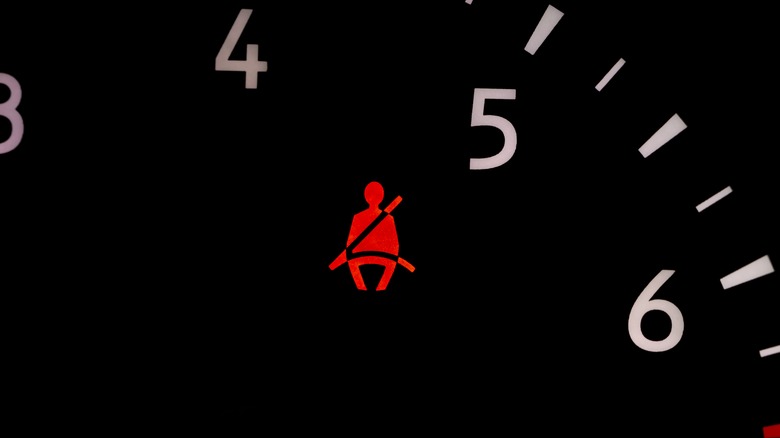Here's What All The Warning Lights On Your Nissan Rogue's Dashboard Mean
The Nissan Rogue has historically been a hit or miss kind of car. While it's largely well-renowned for its compact family size, comfortable cabin, smooth ride, and good fuel economy, the Rogue has had an infamous history of mishaps that has resulted in some models being better than others. But like all cars, Nissans are made with safety in mind. Most of the time, there are some telltale signs you can spot that will indicate when trouble is present before it's too late — and you'll find most of them on your dashboard.
Your Nissan Rogue, like other cars, comes with a series of warning symbols that will pop up on your dashboard from time to time to let you know of problems with your vehicle. It's important to take action as soon as any of these symbols appear on your dashboard. Ignoring them can lead to potentially disastrous results for both your car and, more than likely, your bank account. It might be easy to get overwhelmed by the array of simple — and at times similar — symbols on your Nissan Rogue, but there's no need for it to be such a daunting task. We've detailed what each symbol on your Nissan Rogue dashboard means and what steps to take whenever you see them appear.
Brake issue symbols
You don't need to be an auto expert to understand the importance of functioning brakes for your car. Your Nissan Rogue is no exception, so if something is potentially wrong with your brake system, it will waste no time in alerting you to the problem.
The most obvious dashboard symbol to keep an eye out for is an encircled red circle labeled "Brake." While it's normal for this and your other dashboard symbols to flash briefly when you turn your car on, anything that endures for longer than a few seconds or while you're on the road could be an indicator of something serious. This can include worn out brake pads, low or leaking brake fluid, sensory issues, failed hydraulic valves, or potential electrical problems. In most cases, if you're driving while the symbol comes on, you should be fine for the time being as most cars possess more than one brake hydraulic system that can compensate for any that aren't working. Regardless, you should pull over as soon as possible and, once safely stopped, start making arrangements for your car to get taken to a mechanic, who can properly address and fix the issue.
Likewise, another dashboard icon to be aware of is one labeled "ABS." This stands for Anti-lock Braking System, an important safety feature that automatically pumps your car's brakes to avoid your tires from locking to prevent sliding or skidding. The ABS light will come on for similar reasons as a brake light, including low brake fluid, a blown out fuse, a malfunctioning hydraulic pump, or wiring issues. Once again, a professional should be consulted to officially diagnosis the problem.
Fluid level symbols
Just like every car out there, there are a wide array of fluids that your Nissan Rogue needs in order to function properly. Perhaps the most important of these is the vehicle's engine oil levels. If you see a symbol similar in design to a genie lamp, that's your Engine Oil Pressure Warning Light going off. Whenever you see this, it's more than likely that your oil is simply getting low and needs to be topped off. However, it can also point towards the oil itself being dirty or issues with the oil pressure sensor or pump. If adding more motor oil doesn't stop the problem, then a mechanic should take a look at the issue.
Another one that you may be able to handle on your own is the Low Windshield Wiper Warning. When this icon, depicted as a windshield symbol, lights up, it can often be alleviated by adding more season-appropriate windshield wiper fluid into your vehicle or unclogging blocked nozzles. One that may not be so straightforward to understand at first is an icon that reads PS, which is your Power Steering Warning Light. This is a crucial system that aids the wheels in turning while lessening the strain on your arms, particularly while trying to move your car about in tight spaces, and also requires its fluid levels to be maintained. No matter the problem, unless you are comfortable handling the issue on your own, be sure to consult an auto professional to get help.
Fuel and Battery Deficiency Symbols
Fluid levels are one thing, but warning symbols related to what powers your car can really cause a fright. There are two major symbols to keep an eye on in this category, with each one possessing different levels of difficulty in addressing.
The first and potentially most serious one is the Battery Change Warning Light, which will appear on your Nissan Rogue dashboard as a red battery shaped light. Of course, if you've had your Nissan for a few years, there's a good chance that it might be time to change it, as Nissan batteries typically last anywhere from between three and five years. Sometimes, this can be an indicator of something like built-up corrosion or loosened cables, which can be resolved without professional help depending on your comfort level. But for more intense problems such as wiring issues, internal damage, or a weak alternator, it's best to seek help elsewhere.
A more common signal you're likely to come across after being on the road for extended periods is an icon resembling a gas pump. A good majority of the time, a Low Gas Warning Light will go away as soon as you take your vehicle to your nearest gas station and get a refill. In very rare instances, it may still be on despite the tank being full, which can point to an internal issue, such as a faulty float switch, a blocked fuel tank ventilation hole, a broken fuel gauge, or a failing variable resistor.
People symbols
Among the most important symbols you won't want to ignore on your Nissan Rogue dashboard are any in the shape of people. These are made to indicate that some of your car's most important safety features need to be attended to right away.
One that you've probably seen before as you start up your car is the Seat Belt Warning Light. This will be seen as a red person donning a seat belt, meaning either you or someone else in your car is not wearing their seat belt and no time should be wasted in changing that. Of course, there are rare occurrences where the light could be indicating a more pressing issue with the system itself. The buckle may not be connecting all the way due to debris getting into the slot, or the warning system itself may be experiencing electrical issues. However, these cases are especially rare and most of the time it is pointing towards something that can be resolved on your own.
Another important safety feature you won't want to ignore is an image of what looks like a person with a ball in front of them, also known as your Airbag Warning Light. There are several common reasons for this occurring, including problems with a loose connection, a malfunctioning airbag control module, or weak sensors in one or several parts of the vehicle. Sometimes you may even need to reset the airbag system entirely using a diagnostic tool, although this likely won't solve the problem at hand. Whatever the case might be, unless you're comfortable with altering the system on your own, this is best diagnosed and handled by a professional mechanic.
Exclamation Point symbols
For many of us, the image of an exclamation mark is a universal attention-grabbing symbol. So it should come as no surprise that cars use them so often to indicate potential problems. The same goes for your Nissan Rogue, as there are two important exclamation point icons you'll want to be aware of.
If you ever see an exclamation point enclosed in a horseshoe-type symbol, that's your Tire Pressure Warning Light going off. Driving around for extended periods with such a warning can increase your chances of a tire puncture or blowout while on the road. Sometimes, the light turning on may be attributed to changes in the weather, as colder times of year will typically see the tire pressure drop with the temperature and simply driving for a short amount of time will turn it off. In most cases, however, it will require you to refill it to the recommended PSI levels.
You may also come across an exclamation point inside of a triangle. At first, it might seem like a rather scary sight, especially because it's called the Master Warning Light. However, much of the time it is not cause for excessive concern, acting as a general alert to various elements. This can be something as simple as a loose fuel cap, an open door, or your parking brake still being engaged. Of course, there are other times when it could be pointing towards a bigger issue, such as an overheated engine or malfunctioning safety mechanisms. If you see this symbol, take the time to pull over and inspect your car to try pinpointing the problem before bringing in any professional help.





